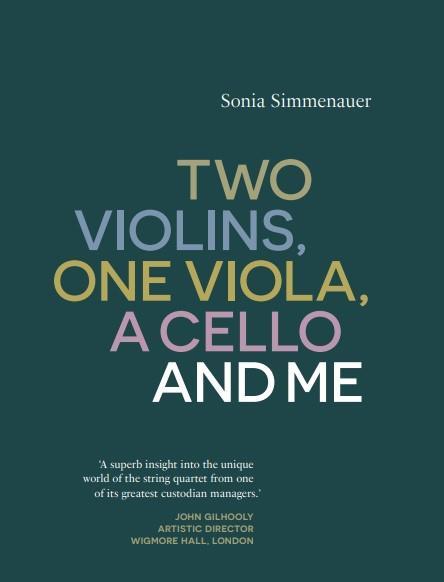Anne Inglis reviews the memoir of classical music agent Sonia Simmenauer, and her encounters with string quartets over the years

Two Violins, One Viola, a Cello and Me
Sonia Simmenauer (trans. Gwen Owen Robinson, Hartmut Kuhlmann)
160PP ISBN 9781399945427
Harcamlow Press £12.99
Sometimes one picks up a book and no superlative is sufficient. This is a book for anyone interested in music, absorbed by personal interactions, captivated by chamber music or simply diverted by life’s minutiae. Sonia Simmenauer was a concert agent for some of the most notable string quartets of the 20th century and beyond. There is an emphasis on groups that were especially known in the US, so some of our most beloved groups of the period, such as the Gabrieli, are not mentioned.
But many of the world’s most notable string quartets were under Simmenauer’s umbrella, and she writes eloquently and poetically about the curious life of the itinerant musician, bound to others through common purpose and artistic endeavour, yet needing to accommodate the twists and turns of the individuals making up the group.
It is a fascinating topic. Simmenauer writes from the beginning about her role, her background and the curious relationship she had with her musicians, whom she knew professionally yet less so personally. She writes of the pedestrian but important details of who pays for what, who decides on the level of luxury for a hotel, what happens if concert clothes are left behind, the unpredictability of rail and air travel, and the vagaries of the individuals too – the moods, the habits of turning up late but just making it on time to walk on to the stage, and the behind-the-scenes difficulties of bad news from home.
The book moves from these practical considerations to the musical ones: the role of practice, how a rehearsal is constructed, and indeed what a rehearsal is for. Walter Levin, the late leader of the LaSalle Quartet, is quoted: ‘Rehearsals are for practising things that have been practised individually. You can’t rehearse what hasn’t been practised. Rehearsals are not for practising!’ This is part of one of many interviews carried out by Simmenauer, and giving a raw authentic voice to the book; there are extended interviews with Günter Pichler (Alban Berg Quartet) and Gregor Sigl (Artemis Quartet), and quotes from Arnold Steinhardt, first violinist of the Guarneri Quartet. These extended interviews run throughout the book and give weight and depth to different areas under discussion.
Throughout the book, there is an elegance of writing, a respect for the life’s work of musicians who might have renounced a more lucrative solo career for the ‘feeling of arriving home, or absolute rightness’ (Steinhardt on the beginning of the Guarneris), and a depth of understanding of the democracy needed within this musical microcosm.
Read: Walter Levin, founder and first violin of the LaSalle Quartet, has died
Watch: Belcea Quartet performs Beethoven’s Grosse Fuge op.133
Read: Alban Berg Quartet founding violinist Klaus Maetzl has died
Simmenauer includes many giants of the quartet performing world, from the Belcea to the Arditti, the Juilliard and the Jerusalem. There is a long list of her representations. Another list gives the repertoire of the Alban Berg Quartet. One of the attractions of the book is the space given to the music, to the importance of a name, to the place of the individuals of the quartet through their background. There is a pleasing unhurriedness to the writing, with chapters exploring topics in depth, with sympathetic understanding of what it means to play in this intensely private yet public world.
Quartets carry a name, and Simmenauer writes on the choosing and finding of names, too. The individuals within them may, of course, be known, but the quartet name is the label, their recognition. Simmenauer alludes to the shock that accompanied the unexpected death of Peter Schidlof, violist in the Amadeus Quartet. I remember the late leader Norbert Brainin in despair as there would be no more Beethoven. Indeed. The Amadeus Quartet died with Schidlof, and there was a rawness at the end of this era that never healed.
A quartet’s name represents the life of a performing entity, subsuming the individual in four musicians’ quest for musical identity and communication. Simmenauer writes from the inside with depth, musical insight and understanding of idiosyncrasy, human foible, and immersion in artistic endeavour.
ANNE INGLIS









































No comments yet